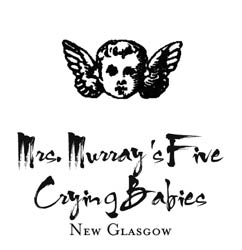The Lunenburg Werewolf (18 page)
Read The Lunenburg Werewolf Online
Authors: Steve Vernon
Tags: #FICTION / Ghost, #HISTORY / Canada / General



It was a cold and bitter day on Wednesday, February 18, 1880, when Dr. William Fraser and a pharmacist by the name of James Jackson hitched up a wagon and clambered aboard to make the rough and dangerous seven-kilometre journey from New Glasgow to a tiny Nova Scotia settlement that was known back then as Little Egypt. The snow was blowing straight at the men as they drove, which made it awfully hard to see.
“Horses, you keep your eyes open,” the doctor warned his team. “Or we're most likely apt to pass right by the homestead and keep on riding right into the open mouth of Little Harbour.”
The horses must have been listening closely because they eventually found their way to the doorstep of sixty-five-year-old Adam Murray and his thirty-seven-year-old wife, Marie. According to Dr. Fraser, Marie Murray was a strong and healthy woman who was already the mother of seven children, and was about to give birth to five moreâat the same time. Unbeknownst to her, Marie Murray was expecting quintuplets.
Within an hour, all five children were delivered. There were three girls and two boys, each as tiny and petite as a little china doll.
The news of the births spread throughout the area within hours. Local folk were soon knocking politely at the Murrays' door, dropping by to see the babies first-hand and to offer up small gifts of food and money to help the family with their unexpected burden.
Marie named the babies after the doctor and the pharmacist, two other prominent members of the community, and the children's own grandmother. Elizabeth MacGregor Murray, the largest baby, was sixteen inches long and weighed in at three pounds, fourteen ounces. Margaret MacQueen Murray was fifteen and a quarter inches long and weighed a strapping three pounds, six ounces. William Fraser Murray reached fourteen and a quarter inches and weighed three pounds, four ounces. James Jackson Murray was fifteen and five-eighths inches long and weighed three pounds exactly. Finally, the smallest of the lot, little Jeanette Rankin Murray reached a length of thirteen and a half inches and weighed in at two pounds, eight ounces.
Sadly, because the babies were so small, their chances of reaching maturity were fairly slim. Three died before the first evening had passed. A fourth died the following morning. And the fifth, little Elizabeth MacGregor, lasted three days before closing her eyes and breathing out the strains of her final lullaby.
An hour before Elizabeth passed away, a newspaper reporter showed up at the Murray residence and persuaded her grieving parents to allow him to line up the five babiesâthe four dead and the one livingâfor a photograph that would appear in newspapers across Canada. The publication of this photo raised quite a commotion for the Murrays. This was the first birth of quintuplets recorded in Canadaâover half a century before the famous Dionne quintuplets were born in 1934 in Corbeil, Ontarioâand the news soon grabbed the attention of people across the country.
Shortly after the photo was published, the Murrays received an offer from famed circus showman P. T. Barnum, who wanted to buy the five tiny bodiesâwhich the Murrays couldn't bury until the spring thaw cameâand have them mummified for display in his circus. The Murrays refused Barnum's offer flatly. When he continued to pressure them, they buried the children in their basement, fearing that a public burial site might be pilfered by unscrupulous grave robbers.
Soon afterward, a local New Glasgow businessman, who preferred to keep his identity strictly anonymous, came forward and offered to bury the infants in an unmarked portion of his family plot in New Glasgow's Riverside Cemetery so that they could lie in sanctified ground. The Murrays gladly accepted the man's offer, and the five babies were finally laid to rest in a proper grave.
But to this day, local residents swear that on certain nights you can hear the gentle haunting sound of five tiny infants wailing for their mother from the heart of New Glasgow's Riverside Cemetery.


The stormy petrel was long considered to be a harbinger of bad weather and worse luck.
Maritimers often refer to this little grey bird as the
“Devil Bird” or “Mother Carey's Chicken.”
Stormy petrels are seen year-round from Nova Scotia and Newfoundland to South America and even as far east as the African coast. Flocks of these dark, swift-flying birds will shoot down out of the clouds and wing past a ship to land in its wake, hoping to catch whatever scraps fall from behind the stern of the vessel.
Some would say that naming a ship after these bad luck birds is a sure way to invite the worst kind of misfortune. Captain David Douglas would likely agree.

A Lumber Run
One fine day in 1890, the lumber barque Stormy Petrel, heavily laden with a cargo of freshly felled timber, unfurled its worn and battered canvas to the cruel Bay of Fundy winds as its captain, David Douglas of Maitland, steered it patiently into the open Atlantic. Captain Douglas was bound for the Bordeaux coastline in far-off France.
The weather was kind to Douglas over the first part of his journey. He was heartily glad of this, for he had his wife, his three-year-old-daughter, and his five-year-old son on board.
Little Eddie Douglas, the captain's son, got along well with the crew of the
Stormy Petrel
, playing games of hide-and-go-seek and tag with them whenever he could. One day, as they were midway across the Atlantic, Eddie splashed water at a crewman and went running from him, giggling. The laughing sailor chased him in good-natured pursuit. Unfortunately, as Eddie was fleeing, he caught his foot in a lashing and tumbled headlong into the open sea.
“Man overboard!” the cry went out.
Captain Douglas heard the call from down in his cabin. He raced to the deck as any good captain would. He took one look at his brave little boy bobbing in the powerful waves and ordered the vessel turned around. Then Captain Douglas dove overboard, without a thought for his own safety. He hit the waves and began swimming strongly, aiming himself towards his floundering son.
Meanwhile, the deckhands quickly got the lifeboat ready and put it over the side. But when the lifeboat hit the waves, it took on water and sank.
In the water, Captain Douglas was having a hard time reaching his son. No matter how hard the captain swam, the current kept taking the boy farther and farther from his grasp.
On the ship, the crew was now being kept busy holding back the captain's wife, who was determined to throw herself overboard after her husband and boy. Her screams of grief and frustration rose high over the waves like the seabird that the vessel was named after.
The
Stormy Petrel
drew closer to Captain Douglas as he swam toward his son. One crewmember threw a life belt overboard to him. The captain caught hold of the belt just as he reached his son. Captain Douglas wrapped the belt around Eddie and tried to keep the young boy's head above the water as the men hauled them back toward the ship.
The crew fought the current for over half an hour to pull the captain and the boy back on deck. By the time they got the pair on board, it was too late. Little Eddie Douglas had drowned in his father's arms. Captain Douglas tried his best to revive his son, but there was no use.
“Build two coffins,” Captain Douglas ordered the ship's carpenter. “Build one small enough for my son and the other large enough to put the first coffin inside with a little room left over.”
The carpenter was terrified that Douglas intended to be buried alongside his son, but nevertheless, he built the two coffins exactly as he'd been ordered to. He soon saw the wisdom behind the captain's instructions.
Then, after placing the boy's body inside the small coffin, and in turn placing that coffin inside the larger coffin, the carpenter filled the space between the two coffins with sticky pitch in order to make it airtight.
“This will keep the bad air inside the coffin during our journey,” Captain Douglas explained. “I mean to see my boy is buried where he'll sleep the soundest.”
When the
Stormy Petrel
sailed into Bordeaux, Captain Douglas placed his son's coffin aboard a fast-moving steamer bound for New York and made arrangements for its safe carriage home. From New York, the coffin was shipped by railcar to Nova Scotia. Then a horse-drawn wagon carried the coffin to the Maitland cemetery, where little Eddie Douglas was finally buried.
Captain Douglas sailed the
Stormy Petrel
back to Maitland, then gave up the ship once and for all. He spent the rest of his days comforting his bereaved wife and raising their little daughter.
In the many years since Captain Douglas's own death, people have often spotted a man's figure standing over little Eddie Douglas's final resting place. Some believe that it is Captain Douglas come back from the dead to keep watch over his son. Others believe that it is the sailor who was playing with the boy right before he fell overboard. Whoever it is, the spectre still appears every once in a while to watch over the boy's grave and to remind people of the tale of the
Stormy Petrel
.
